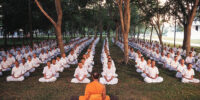Yoga And Mindfulness For Children: Cultivating Calmness And Concentration
Are you looking for ways to help your child reduce stress, improve focus, and enhance their emotional well-being? Look no further than yoga and mindfulness!
In this article, we will explore the benefits of yoga and mindfulness for children and how they can cultivate calmness and concentration.
Yoga and mindfulness have been proven to reduce stress and anxiety in children. By practicing gentle stretches and deep breathing exercises, your child can learn valuable techniques to cope with everyday challenges. Additionally, yoga and mindfulness improve focus and attention span. Through guided meditation and mindfulness practices, children can develop the ability to stay present and engaged in their activities.
Furthermore, yoga and mindfulness enhance self-regulation and emotional well-being. By learning to tune into their emotions and sensations, children become more aware of their inner world and can better regulate their responses. They also develop a stronger mind-body connection, allowing them to navigate their emotions with ease.
Incorporating yoga and mindfulness into your child’s routine is easier than you think! Stay tuned for tips on how to seamlessly integrate these practices into their everyday life.
Key Takeaways
- Yoga and mindfulness activities for children can help reduce stress and anxiety, improve focus, and enhance emotional well-being.
- Techniques such as gentle stretches, deep breathing exercises, guided meditation, and mindfulness practices can be incorporated into a child’s daily routine.
- Specific yoga poses like the tree pose and downward dog pose can benefit children.
- Mindfulness practices can cultivate calmness, bring tranquility to the present moment, improve overall well-being, and help children develop a sense of calmness and concentration in their lives.
Reducing Stress and Anxiety
Are you feeling overwhelmed and anxious? Don’t worry, we’ve got some awesome yoga and mindfulness techniques that’ll help you reduce stress and find your inner calmness.
One effective technique is deep breathing. Take a deep breath in through your nose, hold it for a few seconds, and then exhale slowly through your mouth. This simple exercise can help calm your nervous system and bring a sense of relaxation.
Another great technique is body scanning. Start by focusing on your feet and slowly move your attention up through your body, noticing any areas of tension or discomfort. As you become aware of these sensations, imagine them melting away and releasing any stress or anxiety.
Practicing these techniques regularly can help you cultivate calmness and concentration, allowing you to navigate through life with ease.
Improving Focus and Attention Span
Enhancing focus and attention span is a key aspect of helping kids develop a sense of calm and focus. By practicing yoga and mindfulness, children can improve their ability to concentrate and stay present in the moment.
Here are three ways in which yoga and mindfulness can help improve focus and attention span:
-
Breathing exercises: Teaching children deep breathing techniques can help them regulate their emotions and enhance their ability to focus on tasks.
-
Mindful movement: Engaging in yoga poses and mindful movements can improve coordination and concentration, allowing children to stay focused for longer periods.
-
Visualization techniques: Guided imagery and visualization exercises can help children create mental images that promote concentration and attention.
By incorporating these activities into their routine, children can develop the skills necessary to improve their focus and attention span, leading to increased calmness and concentration in their daily lives.
Enhancing Self-Regulation and Emotional Well-being
By incorporating these simple techniques into your routine, you can experience a greater sense of inner balance and happiness. Enhancing self-regulation and emotional well-being is essential for children’s overall development.
Yoga and mindfulness can help children learn to manage their emotions, reduce stress, and cultivate a positive mindset. Through deep breathing exercises, kids can learn to regulate their emotions and calm themselves down when they feel overwhelmed or anxious. Yoga poses and movements can also help release tension and promote relaxation.
Mindfulness practices, such as guided meditation or focusing on the present moment, can teach children to be more aware of their thoughts and feelings, leading to improved self-awareness and emotional resilience. By incorporating these practices, children can develop a strong foundation for emotional well-being and cultivate a lifelong habit of self-care.
Developing Mind-Body Connection
Developing a strong mind-body connection can lead to a greater sense of inner balance and happiness, allowing you to better regulate your emotions and reduce stress. It involves being aware of the signals your body sends and responding to them in a mindful way. By practicing yoga and mindfulness, you can cultivate this connection and enhance your overall well-being.
To evoke emotion in the audience, imagine a situation where you are feeling stressed and overwhelmed. Your body is tense, your mind is racing, and you find it difficult to focus. Now, picture yourself taking a deep breath, closing your eyes, and tuning into your body. As you do this, imagine a sense of calm washing over you, as if a weight has been lifted off your shoulders. This simple act of connecting with your body can help you find inner peace and improve your ability to concentrate.
| Body Signals | Mindful Response | Result | ||||
|---|---|---|---|---|---|---|
| Rapid heartbeat | Take slow, deep breaths | Increased calmness | ||||
| Tense muscles | Practice gentle stretching | Relaxation | ||||
| Racing thoughts | Focus on the present moment | Improved concentration | Body Signals | Mindful Response | Result | |
| ————– | —————– | ——– | ||||
| Rapid heartbeat | Take slow, deep breaths | Increased calmness | ||||
| Tense muscles | Practice gentle stretching | Relaxation | ||||
| Racing thoughts | Focus on the present moment | Improved concentration | ||||
| Sweating | Engage in deep breathing exercises | Decreased anxiety | ||||
| Clenched jaw | Practice jaw relaxation exercises | Reduced tension | ||||
| Shallow breathing | Take deep breaths and focus on breath | Increased oxygen intake and relaxation | ||||
| Nausea | Practice deep breathing and grounding techniques | Reduced feelings of discomfort | ||||
| Dizziness | Sit or lie down and focus on breathing | Restored balance and stability | ||||
| Fatigue | Take short breaks and practice deep breathing | Renewed energy and focus | ||||
| Difficulty sleeping | Practice relaxation techniques before bed | Improved sleep quality | ||||
| Headache | Practice deep breathing and gentle neck stretches | Reduced tension and headache relief | ||||
| Irritability | Practice deep breathing and mindfulness exercises | Increased patience and calmness | ||||
| Loss of appetite | Practice deep breathing and eat small, nutritious meals | Improved appetite and nourishment | ||||
| Chest tightness | Practice deep breathing and relaxation exercises | Reduced tension and increased relaxation | ||||
| Excessive sweating | Practice deep breathing and relaxation techniques | Reduced stress response and increased calmness | ||||
| Dry mouth | Practice deep breathing and stay hydrated | Relief from dryness and improved comfort | ||||
| Nervousness | Practice deep breathing and positive self-talk | Increased confidence and decreased anxiety | ||||
| Digestive issues | Practice deep breathing and mindful eating | Improved digestion and reduced discomfort | ||||
| Muscle tension | Practice progressive muscle relaxation | Reduced tension and increased relaxation | ||||
| Restlessness | Practice deep breathing and engage in physical activity | Increased calmness and reduced restlessness |
Cultivating Calmness and Inner Peace
To achieve a greater sense of inner peace and tranquility, you can practice connecting your mind and body through various techniques. These include deep breathing, gentle stretching, and focusing on the present moment. These practices can help calm your mind and bring a sense of calmness to your body.
When you engage in deep breathing, you allow yourself to release tension and stress, creating space for relaxation. Gentle stretching helps to release physical tension and promote a sense of ease and comfort in your body. By focusing on the present moment, you bring your attention away from worries or distractions, allowing yourself to fully experience the peace and stillness within.
Embrace these techniques and cultivate a state of calmness and inner peace in your life.
- Take a deep breath in and slowly exhale, letting go of any tension.
- Gently stretch your body, feeling the release of tightness and stiffness.
- Focus your attention on the present moment, letting go of worries and distractions.
- Embrace the peace and stillness within, allowing it to radiate throughout your entire being.
Practicing Mindfulness in Everyday Life
Immerse yourself in the present moment, noticing the gentle breeze on your skin and the vibrant colors of nature around you. Take a deep breath and let go of any thoughts or worries that may be clouding your mind. Mindfulness is about being fully aware of your surroundings and the sensations in your body. It’s about embracing the here and now, without judgment or attachment. By practicing mindfulness in everyday life, you can cultivate a sense of calmness and clarity.
To help you understand the power of mindfulness, imagine sitting in a peaceful garden. In the table below, visualize the sights, sounds, and smells that surround you, bringing a sense of tranquility and connection to the present moment.
| Sights | Sounds | Smells |
|---|---|---|
| Blooming flowers | Birds chirping | Freshly cut grass |
| Sun shining | Leaves rustling | Fragrant flowers |
| Trees swaying | Water flowing | Earthy soil |
By incorporating mindfulness into your daily routine, you can find joy and peace in the simplest of moments. Take a moment to pause, breathe, and fully experience the beauty of the present.
Tips for Incorporating Yoga and Mindfulness into Your Child’s Routine
Take a moment to explore various activities that can be incorporated into your child’s routine, such as gentle stretching exercises and guided breathing techniques, to enhance their overall well-being.
Start by introducing simple yoga poses that promote flexibility and strength. Encourage your child to try the tree pose, where they balance on one leg, or the downward dog pose, where they form an inverted V with their body. These poses not only build physical strength but also improve concentration and focus.
Additionally, incorporate guided breathing exercises into your child’s daily routine. Teach them to take deep breaths in and out, focusing on the sensation of their breath entering and leaving their body. This helps calm their mind and reduce stress.
By incorporating these activities into your child’s routine, you’re fostering a sense of calmness and concentration that’ll benefit them in various aspects of their life.
Frequently Asked Questions
How can yoga and mindfulness help children with behavioral issues?
Yoga and mindfulness can help children with behavioral issues by teaching them self-regulation techniques, improving their focus and attention, reducing stress and anxiety, promoting emotional awareness, and fostering empathy and compassion towards others.
Can yoga and mindfulness be practiced by children with physical disabilities?
Yes, children with physical disabilities can practice yoga and mindfulness. It can be adapted to their needs and abilities, helping them improve their physical and mental well-being.
What are some age-appropriate yoga poses and mindfulness exercises for young children?
Some age-appropriate yoga poses for young children include child’s pose, cat-cow, and tree pose. Mindfulness exercises like belly breathing and body scans can also help them cultivate calmness and concentration.
How long should a child practice yoga and mindfulness each day to see the benefits?
To see the benefits of yoga and mindfulness, children should practice for at least 10-15 minutes each day. Consistency is key, so encourage them to make it a part of their daily routine.
Are there any potential risks or side effects of practicing yoga and mindfulness for children?
There are potential risks and side effects of practicing yoga and mindfulness for children. It is important to ensure they are supervised and practicing proper techniques to avoid injury or overexertion.








